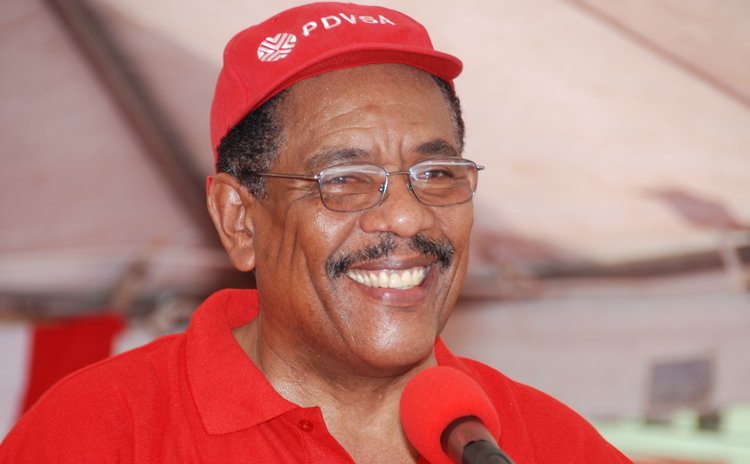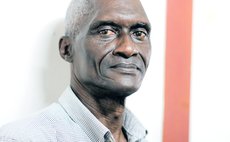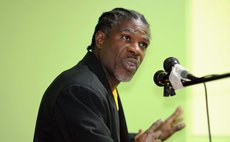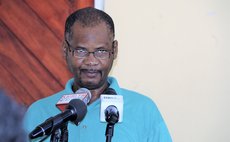The Evil that Men really Do

The October 7th 2013 edition of the SUN Newspaper carried an interview with former Prime Minister Patrick Roland John about the election of President Charles A. Savarin under the banner headline, "The evil that men do". In looking at the headline I thought that the story would have been a confession by Patrick John about the evils he perpetrated against the people of Dominica and the Dominica Labour Party, during his term of office as Premier from 1974 to 1978, and as Prime Minister from 1978 to 1979, and the evil he continued to be involved in even beyond 1979 when he was no longer Prime Minister. As soon as I began to read the article however, I realized that I was expecting too much of Patrick John as he delved into a tirade against Charles Savarin and thought that no one would have responded. In his interview with the SUN Newspaper, he focused on 1979 and the revolt of the people against his administration which resulted in the fall of his government. He blamed Charles Savarin entirely for this. Even after all those years, he accepted no responsibility what so ever. Not a word did he say about Don Pierson's Sunday Island Port Authority and the agreement to allow Dominica to be used to break UN sanctions and to supply oil products and firearms to the apartheid regime in South Africa; not a word about Valhalla; not a word about "jail for civil servants" in his 1978 Newtown Rally; not a word about Sydney Burnett-Alleyne and the plan to overthrow the Government of Barbados; not a word about Red Dog I and Red Dog II, the attempted coups against the Eugenia Charles Freedom Party Government; not a word about the Federal Bank of Dominica in a little house in the outskirts of London; not a word about Mike Perdue and the Klu Klux Klan, etc.
That 1979 uprising was led by the trade unions of Dominica. Charles Savarin was the General Secretary of the largest trade union, the Civil Service Association (CSA) and Chairman of the Joint Trade Union Working Committee. The article refers to Charles Savarin as Patrick John's nemesis and describes him as "uncompromising and unelected, unpopular and unloved". Patrick John recalls "the burning of property belonging to supporters of the Dominica Labour Party, attempts on the lives of others, the looting, the stones," all of which he says flashes before his eyes. He goes on to say that the one thing that stands out, frozen on his memory, is the look on Savarin's face as the crowds stormed the Government Headquarters on this historic morning of 29th May, 1979.
What I want to focus on is Patrick John's reference to "the crowds storming Government Headquarters". As we all know Charles Savarin is but one man, therefore, Savarin could not storm Government Headquarters. How then did the crowds gather and who comprised the crowds which stormed Government Headquarters? As a student of St Mary's Academy at the time, I was there in the crowd. I was not a member of Charles Savarin's union or any union for that matter. I had grown up in a strong Labour Party household, both mother and father. I have therefore always been a Labourite and will always be. My parents and I supported Leblanc; we supported Patrick John even after May 29th 1979, but no more; we supported Michael Douglas; we supported Rosie Douglas; we supported Pierre Charles; and now we fully support Roosevelt Skerrit. So why then was I in the crowd with hundreds of SMA students and their teachers, including my Principal, Brother Egbert Germaine? Why were the Dominica Association of Industry and Commerce (DAIC) and the Dominica Employers Federation (DEF) and their employees also there? Why was the Christian Council, represented by its lay members also there? Why were teachers and students from the various schools in Roseau there? Why were the Trade Unions CSA, WAWU, DAWU, DTU and NWU, present in large numbers? Why was the opposition Freedom Party there? Why were farmers, nurses and persons from all walks of life and all political parties from the length and breadth of Dominica there? Why was the "crowd" the largest gathering of people in Dominica since the night of Independence? Certainly it cannot be because of Charles Savarin! And if it was, then it says something about the man. In fact, it was all about Patrick John and Leo Austin.
Charles Savarin and his union, the CSA had its problems with the government. They had been negotiating for an increase in salaries but instead of seeking to conclude the negotiations, Patrick John, recalling the strikes of 1976 and 1977 and as advised by Leo Austin, his Attorney General, decided to amend the Slander and Libel Ordinance in such a way so as to severely infringe the fundamental rights to freedom of expression enshrined in the Constitution in an attempt to effectively silence media criticism of his government. In addition, he intended to amend the Industrial Relations Act in such a way, so as to severely infringe the fundamental right to freedom of association, also enshrined in the Constitution and to criminalize strike action by civil servants. Patrick John proposed introducing those measures in Parliament on the 29th of May, 1979. The organizations referred to above, that is, the trade unions, the Dominica Association of Industry and Commerce (DAIC), Dominica Employers Federation (DEF) , Christian Council, the opposition Freedom Party, etc., called a public meeting in Lagoon, on the night of the 28th of May to discuss the two proposed amendment acts and possible demonstrations on the grounds of the House of Assembly, which was at the time located at the top floor of Government Headquarters, to convey to Patrick John's government their complete opposition to the proposed legislation. While the public meeting was in progress, word came that at a meeting by Patrick John and his closest supporters at the Goodwill Parish Hall that night, a decision had been taken to ban public gatherings in Roseau on the 29th of May. That decision further infuriated the crowd and it was decided that ban or no ban, they would assemble outside Government Headquarters to let the government know in no uncertain terms their opposition to the government's actions.
The crowd did assemble outside Government Headquarters on the 29th of May, 1979. Members of Parliament arrived for the meeting of the House of Assembly and proceeded through the crowd up the steps of Government Headquarters. Prior to the arrival of Patrick John, however, the Defence Force arrived and began firing teargas to disperse the crowd. The crowd retaliated by throwing stones at Government Headquarters. The Defence Force then opened fire with live ammunition, killing Phillip Timothy and injuring some eleven others. It was this action by Patrick John and his Defence Force which resulted in a strike which lasted for 22 days and saw the resignation of a number of Patrick John's ministers; (the 47 days strike was in 1976 as result of the failure of the government to pay the increase in salaries to civil servants, which had been negotiated and agreed upon in 1974). The 1979 strike precipitated the resignation of a number of ministers of the Patrick John government.
In an effort to bring about a resolution to what was arguably the greatest constitutional crisis ever faced by Dominica, and to do so within the provisions of the Constitution, a twenty six member broad based committee with representation from across a wide spectrum of the Dominican society was put together with Charles Savarin as Chairman. The members of this committee, the Committee for National Salvation (CNS) were: Charles Savarin - Chairman, representing the CSA and Percival Marie (CSA); Louis Benoit and Curtis Augustus (WAWU); A Fredrick Joseph and Norris Charles (DAWU); Rawlins Jemmott and Milton Eloi (NWU); Bernard Nicholas (DTU); Sheridan Gregoire and Norman Rolle (DEF); Julius Sampson and Julius Timothy (DAIC); Lloyd Pascal and Pierre Charles (NYC); Pamela Liburd and Bernie Didier (Social League); Charles Maynard and Father Huysnans (Church Council); Eugenia Charles – Secretary representing the Freedom Party and Brian Alleyne (Freedom Party); Athie Martin and Alvin Armantrading (Farmers Union); Mike Douglas Dominica Liberation Movement (DLM); Rosie Douglas Northern District Agriculture Producers (NDAP); Bernard Wiltshire Dominica Liberation Movement Alliance (DLMA).
A vote of no confidence in Patrick John as Prime Minster was subsequently passed in the House of Assembly. President Degazon having fled out of Dominica, Jenner Amour was appointed as Acting President and Oliver Seraphin was appointed as Interim Prime Minister. All Senators on both sides of the House resigned and nine new Senators from the CNS were appointed. Of course all of these things were only made possible as a result of the massive demonstration which took place on the 29th of May 1979 and the general strike which followed as a result of the actions of the Defence Force.
If one therefore wishes to assess the role of Charles Savarin in these events, it must be seen as one of defending the constitutional rights of the people to Freedom of Expression and the rights of trade union members, more particularly civil servants to freedom of association, and the constitutional form of government which we now enjoy, as there were forces and individuals who sought to take advantage of the situation to propose a coup d'état and the setting up of a revolutionary government as had occurred in Grenada. It was as a result of Charles Savarin's vehement opposition to a coup, that Bernard Wiltshire referred to him as an "Ayatollah", as Savarin let it be known to Wiltshire and others that the unions will remain on strike should they attempt to have a coup in Dominica.
There are a lot of other details surrounding this episode in Dominica's history, some of which can be found in Chapter 21 of Lennox Honeychurch's book "The Dominica Story"; in the Report of the Commission of Inquiry into the Death of Phillip Timothy; in a pamphlet written by DAWU's former General Secretary A Fredrick Joseph (now deceased); in the book "Bayou of Pigs", written by Stewart Bell; in the CSA's newsletters before and during the strike; and in the pages of the Chronicle in the period leading up to May 29th 1979. To fully appreciate the depth of opposition which fueled the actions of the people on May 29th 1979, one needs to read the Industrial Relations (Amendment) Act of 1979 and the Slander and Libel (Amendment) Act of 1979 and to ask oneself how would our newspapers and radio stations, as well as our trade unions particularly the PSU, function today, if Charles Savarin had not stood up and galvanized the people as he did in 1979
Cecil Joseph - Laborite




